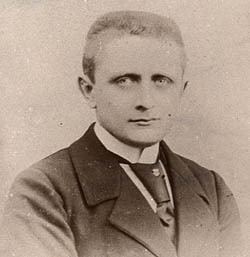Name Paul Ladmirault | ||
 | ||
Died October 30, 1944, Camoel, France | ||
Paul Ladmirault - Le Chemin Creux (4 Esquisses pour Piano, No.1)
Paul Ladmirault : Danse Bretonne (Allegro moderato e scherzando)
Paul Ladmirault (8 December 1877 – 30 October 1944) was a French composer whose music expressed his devotion to Brittany. Claude Debussy wrote that his work possessed a "fine dreamy musicality", commenting on its characteristically hesitant character by suggesting that it sounded as if it was "afraid of expressing itself too much". Florent Schmitt said of him: "Of all the musicians of his generation, he was perhaps the most talented, most original, but also the most modest". Peter Warlock dedicated his Capriol Suite to him.
Contents
- Paul Ladmirault Le Chemin Creux 4 Esquisses pour Piano No1
- Paul Ladmirault Danse Bretonne Allegro moderato e scherzando
- Life
- Breton Celticism
- Opera and ballet
- Orchestral music
- Chamber music
- Vocal music
- Others
- See also
- References
Life
Ladmirault was born in Nantes. A child prodigy, he learned piano, organ and violin from an early age. At the age of 8, he composed a sonata for violin and piano. At the age of fifteen, when still a student of the Nantes High School, he wrote a three-act opera Gilles de Retz. It was first performed on 18 May 1893.
He was admitted to the Paris Conservatoire to study under Gabriel Faure, learning harmony under Antoine Taudou and counterpoint from Andre Gedalge. He orchestrated a few works by Faure. Like his fellow students - Maurice Ravel, Florent Schmitt, Louis Aubert, Jean Roger-Ducasse, Georges Enesco - he had become well known before he left the Conservatory. In 1903, he wrote a Breton Suite in three movements and then the Broceliande de matin. These two works were orchestral extracts from his second opera, Myrdhin (Merlin), an epic work which he worked on from 1902-9, and continued to revise until 1921, but which has never been performed.
He also wrote Young Cervantes for small orchestra, Valse triste and Epousailles for orchestra and piano. The ballet, La Pretesse de Korydwenn (The Priestess of Ceridwen) was created at the Paris Opera on 17 December 1926.
In the field of religious music, he wrote a brief Mass for organ and choir, and a Tantum ergo for voice, organ and orchestra.
He also wrote articles on music in various periodicals. Appointed professor of harmony and counterpoint at the Nantes conservatoire, Ladmirault rarely left the Nantes region, calling himself a "homebody" who disliked to travel.
Breton Celticism
All Ladmirault's music is imbued with his attachment to Brittany. It is found throughout his Gaelic Rhapsody, Briere, Forest and Symphony in four movements. He was also closely associated with Breton nationalism. He advocated cultural autonomy for Brittany in the face of the centralisation of French culture in Paris and became a subscriber of the Breton fascist paper Breiz da Zont, an offshoot of the Breton Autonomist Party. He also joined the artistic group Seiz Breur. He was initiated into the Celtic esotericist movement led by Francois Jaffrenou. In 1908, the Gorsedd of Brittany nominated him as a Druid, and he took up the bardic name 'Oriav'. He composed music on Celtic themes, such as the ballet La Pretesse de Korydwenn, and the symphonic poem he wrote as musical accompaniment for the film La Briere. He worked on translations of ancient Gallic texts.
In 1928 Ladmirault published a manifesto of Breton music in the first issue of the Celticist journal Kornog. He argued that Breton composers should follow the example of the Mighty Handful, the Russian nationalist musical group, by rejecting German and Italian musical models and relying on folk traditions and pentatonic scales. Nevertheless, he took the view that Breton folk music was cruder than its "civilised" Irish and Scottish counterparts. He justified his use of only Irish musical sources in his Celtic ballet La Pretesse de Korydwenn, writing "several themes, jigs, war dances are Irish. You would find no borrowings from Breton folk music".
In 1929, he helped to found the Nantes Celtic Circle.
Opera and ballet
- Gilles de Retz, opera, performed at Nantes, 18 May 1893,
- Myrdhin, opera, completed 1921 (never performed)
- La Pretesse de Korydwenn, ballet performed by l'Opera-Comique, 17 December 1926,
- Glyceres, operetta (Paris, 1928).
Orchestral music
- A symphony in four movements, (1909),
- En Foret, symphonic poem, performed on Jan 31 1932 by l'Orchestre symphonique de Paris, conducted by Eugene Bigot,
- Suite bretonne (1903),
- incidental music for Tristan et Iseult by Joseph Bedier and Louis Artus (Nantes, 1929),
- Valse triste, for piano and orchestra, performed at Paris, 4 March 1934,
- Broceliande au matin, symphonic poem (Concerts Colonne, 28 November 1909),
- Epousailles, for piano and orchestra
- La Briere, orchestral suite, 1925
- La Jeunesse de Cervantes, for small orchestra.
Chamber music
- String Quartet (1933),
- Fantaisia for violin and piano (1899),
- Chevauchee, fantasia on Scottish reels, trio for violin, violincello and piano,
- Romance for string quartet
- The River, trio in E Major for violin, violincello and piano,
- Memoirs of an Ass, after Sophie Rostopchine, Comtesse de Segur,
- String Quintet (1933),
- Shadow and Light for violin and piano (1935),
- Sonata for violin and piano (1931),
- Sonata for violincello and piano (1939),
- Sonata for clarinet and piano (1942),
- Carillon (1929),
- Variation on airs biniou for two pianos
- Choral and Variations (1936) for piano and wind quintette
- Four Piano Sketches: Chemin creux - Valse melancolique - Vers l'eglise dans le soir - Minuit dans les clairieres,
- Piano Pieces (Breton Suite for two pianos).
Vocal music
- Old Melodies, for tenor, string quartet and piano (1897),
- Brief Mass, for choir and organ,
- Tantum ergo for voice, organ and orchestra.
Others
- melodies,
- numerous arrangements of traditional Breton songs,
- Two Breton Dances, published posthumously.
